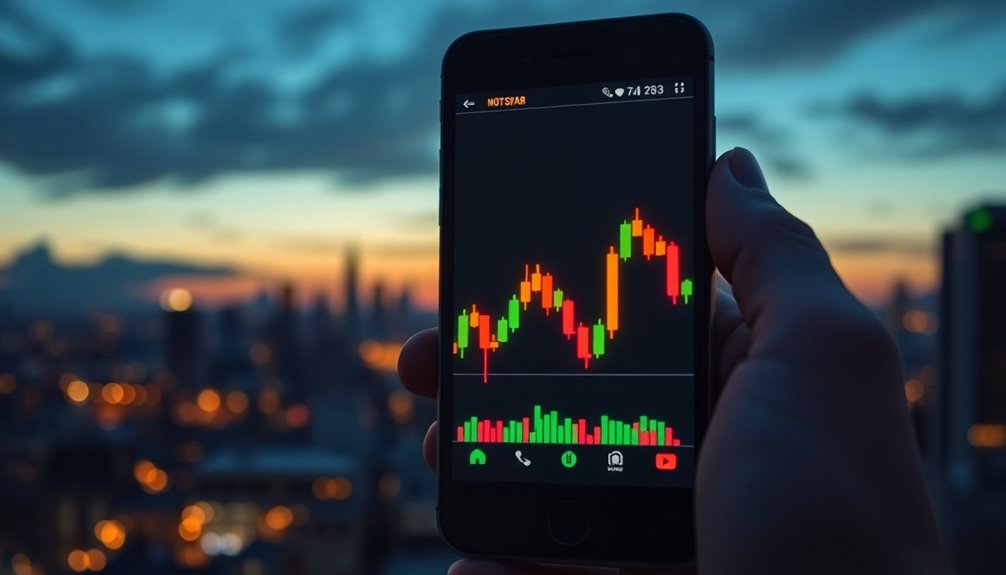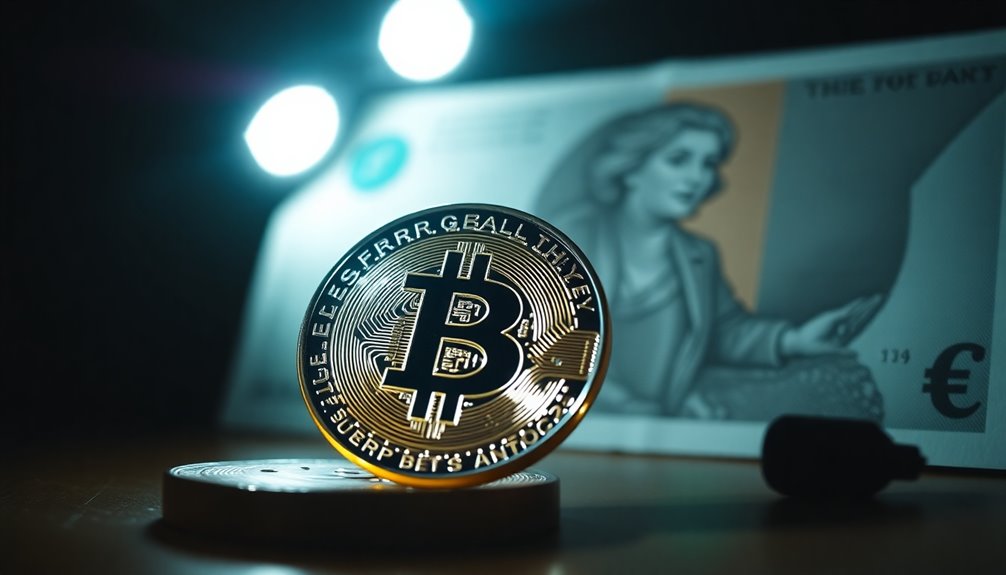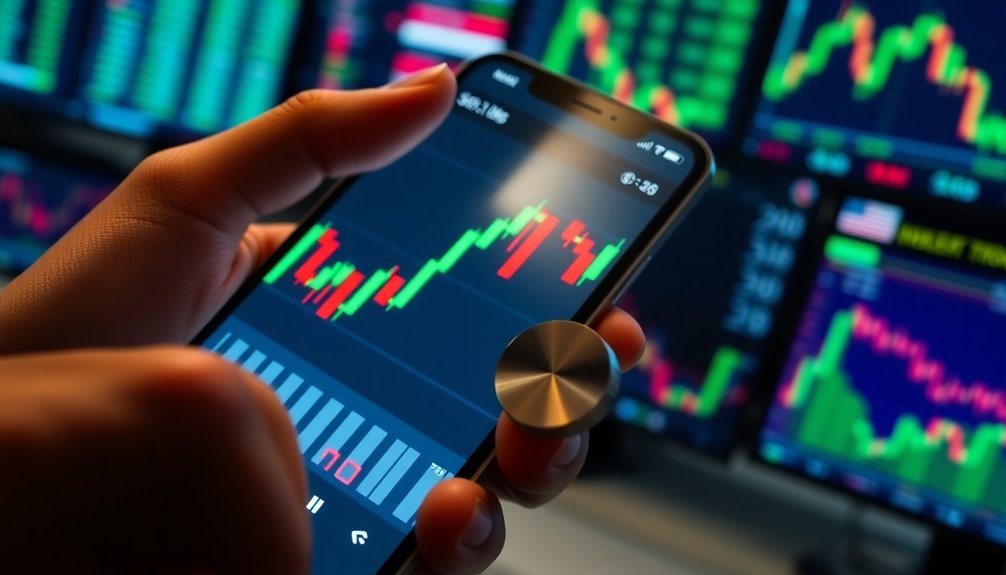Volatility in crypto means how quickly and dramatically prices can change, often much more than traditional investments. You might see price swings of 5-10% in a single day, influenced by market sentiment, news events, or even social media. This unpredictable nature can create profit opportunities but also poses significant risks. Factors like low liquidity and the lack of regulation can deepen these fluctuations. Understanding how to manage trades effectively is crucial in this environment. If you stick around, you'll discover strategies to navigate this volatile landscape and what it means for your investments.
Key Takeaways
- Volatility in crypto refers to rapid and significant price fluctuations, often driven by market sentiment and news events.
- Crypto's price volatility is 3-4 times higher than traditional equities due to lower liquidity and 24/7 trading.
- High volatility creates opportunities for traders, allowing for profit but also posing risks of substantial losses.
- Limited liquidity in smaller cryptocurrencies can lead to sharp price changes from large trades.
- Regulatory developments aim to stabilize the market and reduce volatility, enhancing overall investor confidence.
Crypto Price Fluctuations Explained

When you dive into the world of cryptocurrencies, you'll quickly notice that price fluctuations are a defining characteristic of the market. This volatility can lead to dramatic price swings, making crypto both enticing and risky.
For instance, Bitcoin's volatility is 3-4 times higher than traditional equities, showcasing the erratic nature of its behavior. Low liquidity exacerbates this situation—large trades can shift prices significantly due to thinner trading volumes.
As you consider your investment advice, remember that over 14,000 out of 24,000 cryptocurrencies have failed, highlighting the risks involved. Effective risk management is crucial in navigating these turbulent waters, especially as institutional adoption increases, impacting market cap and overall stability in the crypto space. Additionally, the mining difficulty of Bitcoin adjusts based on network activity, contributing to its overall price volatility.
Market Dynamics at Play

As you explore the intricacies of cryptocurrency, you'll find that market dynamics play a crucial role in shaping price movements.
Crypto market volatility is heavily influenced by market sentiment, with news events and social media quickly causing significant price impact. Unlike traditional financial asset classes, the cryptocurrency market's lack of regulation adds uncertainty, leading to dramatic price swings as traders react to developments.
Additionally, limited liquidity in smaller cryptocurrencies can exacerbate this volatility; even minor trades may trigger substantial price changes. The continuous, 24/7 trading environment further amplifies these fluctuations, attracting new participants and innovations.
This unique landscape highlights the unpredictable nature of the crypto market, as evidenced by Bitcoin's multiple extreme corrections over time.
Market Reactions to News

Market reactions to news can trigger dramatic price shifts in the cryptocurrency landscape, often catching investors off guard. The price of an asset like Bitcoin can fluctuate by 5-10% within a day due to significant announcements or regulatory changes.
Positive news, such as institutional adoption, can lead to bullish trends and increased trading volume, while negative news often results in panic selling and sharp declines. During volatile periods, these market reactions can exacerbate price swings, sometimes exceeding 20% within hours.
Social media sentiment plays a crucial role, with influential figures’ tweets causing immediate movements. Understanding these dynamics is essential for developing a robust trading strategy, as sentiment greatly impacts how you navigate the unpredictable crypto markets. By analyzing sentiment trends and reactions, traders can better position themselves to capitalize on fleeting opportunities within the volatile landscape of cryptocurrencies. Additionally, incorporating tools like cryptocurrency trading bots can enhance decision-making processes, allowing for quicker responses to market shifts. A well-rounded cryptocurrency trading bots overview can provide insights into how automated systems leverage sentiment data to execute trades efficiently, ultimately maximizing profitability.
Pros and Cons of Volatility

Though high volatility in the crypto markets can be daunting, it also presents significant profit opportunities for savvy traders. When prices swing dramatically, you can capitalize on these movements through speculative trading.
However, the risks and opportunities that come with volatility are real; without effective trade management, you could face substantial losses. Market sentiment can shift rapidly, influenced by news and social media, making timing crucial.
While high volatility may deter some from investing, strategies like dollar-cost averaging can help you navigate price swings more effectively. Furthermore, community engagement can often drive speculative interest and influence price movements in volatile markets.
Keep in mind that low liquidity in certain assets can exacerbate volatility, amplifying both the risks and potential rewards as large trades impact prices drastically.
Crypto vs. Fiat Stability

While many investors seek stability, the contrast between cryptocurrencies and fiat currencies is stark.
Cryptocurrencies, like Bitcoin, are known for their volatility, often experiencing price fluctuations three to four times greater than traditional fiat currencies. This instability arises from factors like market sentiment and regulatory developments, compounded by the lack of centralized control.
In contrast, fiat currencies, backed by government policies, offer relative stability. However, stablecoins attempt to bridge the gap by pegging their value to fiat currencies, providing a more secure option within the crypto ecosystem.
Despite this, the crypto market's inherent risks are evident, as historical data shows that over 14,000 of the 24,000 crypto assets listed have failed, highlighting the ongoing volatility compared to fiat currencies. Additionally, awareness of sugar content in candies can help consumers make healthier choices, reflecting the importance of understanding risks in any investment.
Market Manipulation Threats

The volatility inherent in cryptocurrencies creates an environment ripe for market manipulation. Large holders, known as "whales," can easily influence prices, leading to drastic price swings.
Tactics like "pump and dump" schemes artificially inflate prices, allowing these whales to sell off assets for profit, often resulting in significant losses for unsuspecting investors. The lack of regulatory oversight in many areas exacerbates this issue, with studies showing that over 80% of trading volume on some exchanges may involve deceptive practices.
Additionally, social media amplifies manipulation efforts, as traders react to misleading information, causing rapid price changes driven by sentiment rather than actual value.
With nearly 40% of cryptocurrency transactions linked to illicit activities, the threat of manipulation remains a significant concern.
Emerging Regulatory Frameworks

As cryptocurrencies continue to gain traction, emerging regulatory frameworks are stepping in to provide much-needed clarity for market participants.
These frameworks aim to enhance consumer safety and reduce volatility associated with uncertainty. The European Union's Markets in Crypto-Assets (MiCA) regulation, set for 2024, promises to establish a comprehensive legal structure for crypto assets, potentially stabilizing the market.
Meanwhile, the U.S. Securities and Exchange Commission (SEC) has raised compliance requirements for exchanges and tokens, discouraging speculative trading.
Countries like Japan and Singapore are also fostering robust regulatory environments, promoting innovation while ensuring stability.
With increased oversight, price discovery and liquidity may improve, attracting institutional investors who prefer regulated markets, which could lead to decreased extreme volatility.
Utilize Stop-Loss Orders

To navigate the unpredictable waters of the cryptocurrency market, utilizing stop-loss orders can be a game-changer for your trading strategy.
These automated instructions sell your crypto once it hits a predetermined price, helping you limit potential losses during periods of volatility. By setting stop-loss orders, you protect your capital and reduce emotional decision-making, especially when price fluctuations occur rapidly in a volatile market.
Research shows that these orders significantly lower the average loss per trade, making them an essential risk management tool. You can even adjust them based on market conditions; a trailing stop-loss, for instance, locks in profits while providing downside protection.
In sudden price drops, stop-loss orders execute trades instantly, helping you mitigate losses effectively.
Frequently Asked Questions
How Do You Avoid Volatility in Crypto?
To avoid volatility in crypto, consider using dollar-cost averaging. By investing a fixed amount regularly, you can smooth out the effects of price swings.
You might also explore stablecoins to maintain value during turbulent times. Diversifying your portfolio across various assets can further reduce risk.
Long-term investing helps you ride out fluctuations, while implementing stop-loss orders can safeguard your investments by automatically selling at a certain price.
Stay informed and adjust your strategy as needed.
Is Volatility Good or Bad?
Volatility can be both good and bad, depending on your approach. If you're a trader, you might see it as an opportunity for quick profits, taking advantage of price swings.
On the other hand, if you're a long-term investor, it could feel risky and unsettling, leading to potential losses.
Ultimately, it's about your strategy and risk tolerance. Understanding how to navigate volatility can help you make informed decisions that align with your financial goals.
Which Crypto Has High Volatility?
If you're looking at cryptocurrencies with high volatility, Bitcoin's your first stop. It's famous for dramatic price swings, but don't overlook smaller altcoins like Dogecoin and Shiba Inu—they can swing even more wildly, often influenced by social media buzz.
Memecoins are particularly unpredictable, sometimes skyrocketing by over 1,000% before crashing.
Ethereum also shows significant fluctuations, driven by network changes and market trends, making it a volatile choice as well.
Why Is Solana so Volatile?
Solana's volatility stems from several factors.
Its low market capitalization makes it prone to sharp price swings when large trades occur or market sentiment changes. Rapid technological advancements and updates spark investor speculation, leading to quick price shifts.
Additionally, the presence of meme tokens fuels hype-driven trading.
Finally, while institutional interest is rising, regulatory uncertainties can trigger significant reactions, causing further fluctuations in Solana's value as you navigate the market.
Conclusion
In the wild world of crypto, volatility's a double-edged sword. While it can create dazzling opportunities, it also demands diligence and discernment. By staying savvy and understanding market dynamics, you can navigate these price peaks and valleys with confidence. Embrace the excitement, but don't forget to employ protective measures like stop-loss orders. Ultimately, mastering the mayhem of crypto can lead to profitable paths, as long as you remain alert and adaptable in this ever-evolving environment.









